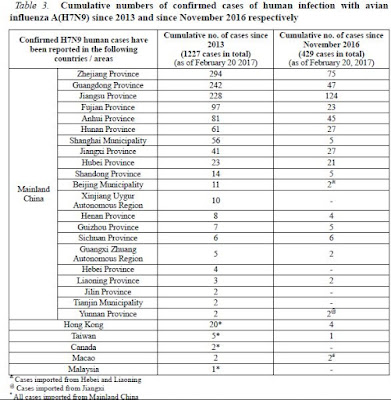#12,246
Hong Kong's CHP has published their latest weekly avian influenza report, which includes an increase of 67 H7N9 cases from the Mainland over last week's tally.
They now report 422 Mainland cases since November of 2016 (plus 4 in Hong Kong and 2 in Macao), more than tripling last year's 12 month tally in only 90 days.
The majority of these cases were announced five days ago (see HK CHP Notified Of 61 Addtional Mainland H7N9 Case), all reported to the NHFPC between Feb 6th-12th. Without onset dates, however, we don't have a good handle of when these patients become infected.
As a general rule, only the `sickest of the sick' - those ill enough to be hospitalized - are tested for the virus How many cases are flying beneath China's surveillance radar is a big unknown. The official count, however, is assumed to be a fraction of the actual burden of the disease (see Beneath The H7N9 Pyramid).
Of the 67 cases detailed in today's report, nearly half are listed as `Under Investigation', leaving us with no condition or outcome. Of the 36 where a condition is shown, 9 are listed as a fatal outcome, while 15 are listed as either `Critical' or having `Severe Pneumonia'.
Over its 4 year history H7N9 has proven fatal in 30% to 40% of known cases. Its true CFR (case fatality ratio) is assumed to be much lower, since people with mild or moderate illness are not factored in.Once again (for cases where data is provided), males outnumber females by more than 2:1, and the skewing towards older cases continues, with only 2 (of 67) cases under the age of 30. Both have been consistent trends with this virus.
The full report (which runs 11 pages) is well worth downloading and reading, as it contains updates not only on avian flu activity in Mainland China, but around the world.
Avian Influenza Report
Avian Influenza Report is a weekly report produced by the Respiratory Disease Office, Centre for Health Protection of the Department of Health. This report highlights global avian influenza activity in humans and birds.
VOLUME 13, NUMBER 07
Reporting period: February 12, 2017 – February 18, 2017 (Week 07)
(Published on February 21, 2017)
Summary
1. Since the previous issue of Avian Influenza Report (AIR), there were 67 new human cases of avian influenza A(H7N9) reported by Mainland China health authorities in Hubei (11 cases), Zhejiang (10 cases), Jiangsu (9 cases), Guangdong (7 cases), Anhui (6 cases), Hunan (6 cases), Fujian (5 cases), Jiangxi (5 cases), Shandong (2 cases), Sichuan (2 cases), Beijing (1 case), Guangxi (1 case), Guizhou (1 case) and Yunnan (1 case). Since March 2013 (as of February 20, 2017), there were a total of 1227 human cases of avian influenza A(H7N9) reported globally. Since November 2016 (as of February 20, 2017), 422 cases have been recorded in Mainland China.
2. Since the previous issue of AIR, there were no new human cases of avian influenza A(H5N6). Since 2014 (as of February 18, 2017), 16 human cases of avian influenza A(H5N6) were reported globally and all occurred in Mainland China. The latest case was reported on December 1, 2016.
3. There were no new human cases of avian influenza A(H5N1) reported by the World Health Organization (WHO) in 2017. From 2011 to 2015, 32 to 145 confirmed human cases of avian influenza A(H5N1) were reported to WHO annually (according to onset date). In 2016, there have been 10 cases in Egypt.*
* Since November 21, 2012, WHO only publishes information on human cases with avian influenza A(H5N1) infection in “Influenza at human - animal interface: Monthly Risk Assessment Summary”. Only cases of human infection with H5N1 involved in events that are unusual or associated with potential increased risks will be reported in Disease Outbreak News. The latest report was published in January, 2017.
As we discussed just over two weeks ago in The Skies Aren't They Only Thing Hazy In China, data from the Mainland on this year's avian flu epidemic has become increasingly fragmented and delayed, and our ability to track the size and scope of this 5th wave of H7N9 cases continues to be severely hampered.
That said, cases still appear to be primarily linked to live bird/poultry exposure, the clusters we've seen reported have been small and infrequent, and we've not seen any evidence of sustained or efficient human-to-human transmission.

